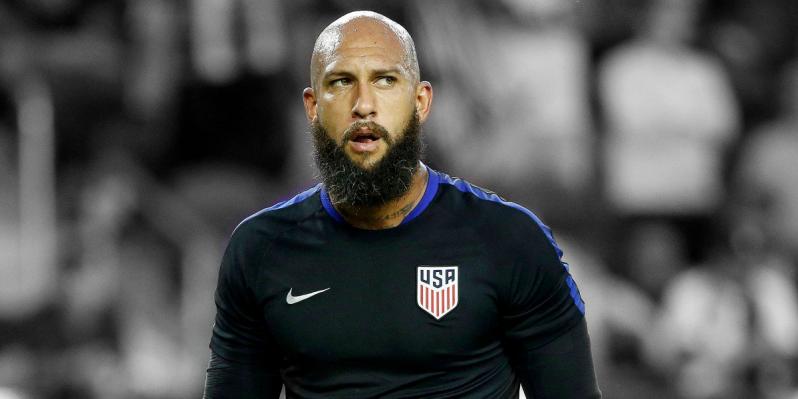The USMNT’s failure to qualify for the 2018 World Cup is nothing less than an abject failure. It’s a failure for U.S. soccer on so many levels, from player development and youth organization to individual performances and coaching decisions. It’s a failure that must be learned from so as to never repeat it again.
International soccer is littered with instances of countries learning from failure and rising to the top of the game. If the U.S. Soccer Federation can follow the examples set by nations like Italy, France and Germany, it can ensure the U.S. Men’s National Team recovers, rebuilds and reemerges better than before. But U.S. soccer is tricky, and it won’t be easy.

We feel ya, Christian. Photo: @ESPNFC | Twitter
Before we get any further, it’s probably necessary to say that U.S. soccer will be fine in the long term. There is too much investment in soccer infrastructure for the USMNT to just fade away like it did from 1954 to 1986, the last time it failed to reach a World Cup. But the degree to which Team USA rebounds depends upon decisions that will be made in the coming months and years.
Change From Top To Bottom
In 2014, Germany won its fourth World Cup, tying Italy for second most behind Brazil. Die Mannschaft won with a squad whose origins came back in 2000. That year, Germany failed to escape its group at the Euros following back-to-back quarterfinal exits at the two prior World Cups. For a squad that had reached at least the semifinals in its first 12 World Cups, this was alarming and Germany recognized the need to rethink how they do football.
What ensued was an overhaul of the German youth development system. While many changes began after the 1998 flop, by 2001 it was compulsory for the every professional club in Germany’s top two leagues to support their own youth academies. The idea was to not let any player fail to live up to his potential because of a lack of coaching. As a result, development of German youth players improved dramatically.
By the 2011-12 season, more than 50 percent of all Bundesliga players had come through the German academy system. At the 2014 World Cup, Germany was a machine, beating host Brazil 7-1 on the way to its fourth World Cup title, with Borussia Dortmund youth product Mario Gotze scoring the winning goal in the final.
Germany’s construction of a new development structure was not dissimilar to what France went through about a decade before. With France set to host the 1998 World Cup, the French wanted to make sure they had a good product on display for their home fans after failing to qualify for the two prior editions following back-to-back semifinal appearances. What ensued was a revamp of the youth development system that paid off with the nation’s only World Cup crown.
In 1970s, Italy’s Serie A was home to some of the best clubs in the world, but big money brought in a number of foreigners and the Azzurri struggled as a result, failing to qualify for the 1972 and ’76 Euros and going out in the 1974 World Cup group stage. Then Serie A put restrictions on the number of foreign players allowed and by 1982 Italy won its third world championship.
Because Major League soccer isn’t on the level of Serie A or Bundesliga, American players should do the opposite and compete abroad as much as possible.
U.S. Exceptionalism
U.S. soccer is a different beast than Germany, France and Italy, countries with immensely more footballing tradition. There are many factors working against the U.S. following their examples. For starters, the U.S. is on a bit of a soccer island. Outside of Mexico, there are no nearby countries with consistently strong teams. No nation has won a World Cup that does not border another country that has won a World Cup (if you consider England and France as bordering each other). This is not a coincidence. The better the competition around you, the more you improve.
The fractured nature of U.S. soccer at the youth level makes an overhaul of player development difficult. By the same token, despite improvements to academies run by MLS clubs, given the size of the country it’s near impossible to ensure players don’t slip through the cracks.

Tim Howard is past his prime but who will replace him? Photo: @MLS | Twitter
To be fair, the U.S. has a population larger than every World Cup winner ever and could make up for missing out on players with sheer numbers. But the simple fact is, unlike the top teams in the world, American soccer must compete for top athletes with American football, basketball and baseball. Thus, it’s just as important for the U.S. to provide proper coaching and development for every possible soccer prospect as it is for a country like Uruguay, a nation with 100 times fewer citizens but two more World Cup championships.
Bruce Arena said after Tuesday’s loss that nothing has to change for U.S. soccer. In a way, he’s right. The U.S. would probably qualify for most World Cups by keeping things the way they are. But at the same time, if the U.S. really wants to compete with the top nations in the world, it must recognize the need for change.
There are many Americans that know all of this and have great ideas on how to improve U.S. soccer based on examples set throughout the world. But none of these ideas will be easily implemented and that’s partly why none of them have been fully instituted.
It’s unlikely the U.S. will ever treat soccer the way Germany, France and Italy do. American football, basketball and baseball are too ingrained in the American psyche for soccer to ever completely overtake them all (though baseball better watch out). But if the U.S. can learn from those nations, learn from defeat, learn from the disaster of a 2018 qualifying campaign, maybe some good can come from Tuesday’s shocking setback.

 Home
Home


